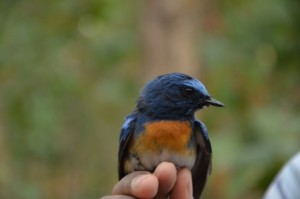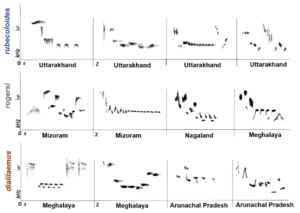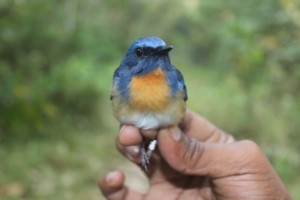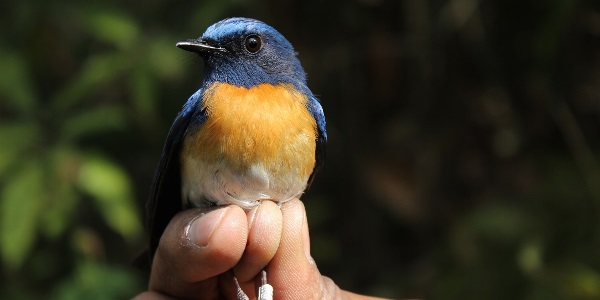LINKED PAPER
Taxonomy of cryptic species in the Cyornis rubeculoides complex in the Indian subcontinent. Singh, A., Gupta, S.K., Alström, P., Mohan, D., Hooper, D.M., Kumar, R.S., Bhatt, D., Singh, P. & Price, T.D. 2019. IBIS. DOI: 10.1111/ibi.12735. VIEW
Cyornis Flycatchers are superficially similar, and there is much ambiguity in their distribution and status in the Himalayan region. Due to misidentification, difficulty in detection, rarity, and inconsistent taxonomy, this species complex is subject to much ongoing research (e.g., Baruah et al. 2018).
In this study, my colleagues and I assessed the taxonomic status of the Blue-throated Flycatcher Cyornis rubeculoides complex in the Himalayan part of India, which was previously described as consisting of two similar subspecies. We used mitochondrial and nuclear DNA, plumage traits and detailed song analysis to assess the taxonomic status across multiple populations.

Figure 1 Nominate rubeculoides from Uttarakhand © S K Gupta
Five subspecies of the Cyornis rubeculoides complex, i.e., rubeculoides, dialilaemus, rogersi, glaucicomans and klossi have been described. Zhang et al. (2016) studied the complex in Southeast Asia and reported that the subspecies glaucicomans should be elevated to species level (Cyornis glaucicomans), and merged the subspecies klossi with a closely related species Cyornis hainanus based on genetics. Consequently, only three subspecies of rubeculoides remain. They include the subspecies rubeculoides (nominate, west Himalaya) and dialilaemus (eastern Himalaya) known to occur in Himalayan region, and rogersi thought to breed in southeast Asia (Zhang et al. 2016).
During the initial phase of the study we listened to multiple recorded songs of Cyornis rubeculoides subspecies and found little difference. We conducted some preliminary playbacks between individuals of different populations, and found little differences in responses. However, the subspecies do differ in the plumage. The western population has round blue band throat, whereas, the eastern population has deep rufous inverted ‘V’ on throat, which we call a notch (Rasmussen & Anderton 2012) We visited eastern Himalayan states such as Meghalaya, Mizoram, Nagaland, Arunachal Pradesh and western Himalayan state Uttarakhand for genetic sampling.

Figure 2 Song sonograms of rubeculoides, rogersi and dialilaemus
A time dated phylogeny shows a split of all individuals into three major clades. One clade contains all western individuals, the second, individuals from the high elevations of the northeast hills (~900m), and the third, individuals of east Himalaya low elevations (~300m) from both north and south of the Brahmaputra. The northeast high elevation population clusters with the rogersi samples collected from Mt. Victoria, Myanmar (Zhang et al. 2016), from which we estimate it diverged 1.5 mya. The low elevation populations form a clade with hainanus, from which it separated about 0.8 mya.

Figure 3 Subspecies dialilaemus from Meghalaya © Ashutosh Singh
On the basis of these findings, we show that subspecies dialilaemus, in the northeast hills and the east Himalaya, does not belong in C. rubeculoides. It could be a sister species of C. hainanus (0.8 mya separation only) or a distinct species. Also, this study reports for the first time the existence of subspecies rogersi in the northeast hills of Himalayan region. We have not been able to visit intermediate elevations in the northeast hills to determine if the low and high elevation taxa actually come into contact, and how they interact if they do. This work provides another example of the presence of cryptic species in the Himalayan region.
Nominate this article for a BOU Science Communication Award.
References and further reading
Baruah, P., Dalvi, S., & Hatibaruah, B. 2018. Notes on field identification, vocalisation, status, and distribution of Large Blue Flycatcher Cyornis magnirostris and Hill Blue Flycatcher Cyornis banyumas whitei in north-eastern India. Indian Birds 14(4): 102–108. VIEW
Gwee, C.Y., Eaton, J.A., Garg, K.M., Alström, P., van Balen, B., Hutchinson, R.O., Prawiradilaga, D.M. & Rheindt, F.E. 2019. Cryptic diversity in Cyornis (Aves: Muscicapidae) jungle flycatchers flagged by simple bioacoustic approaches. Zool. J. Linn. Soc. In press. VIEW
Rasmussen, P.C. & Anderton, J.C. 2012. Birds of South Asia: The Ripley guide. Vols. 1 and 2. Second ed. Washington, D.C., Michigan, and Barcelona: National museum of Natural History- Smithsonian Institution, Michigan State University and Lynx Edicions
Robinson, H.C. & Kinnear, N.B. 1928. Notes on the genus Cyornis Blyth. Novitates Zoologicae 34: 231–261.
Zhang, Z., Wang, X., Huang, Y., Olsson, U., Martinez, J., Alström, P. & Lei, F. 2016. Unexpected divergence and lack of divergence revealed in continental Asian Cyornis flycatchers (Aves: Muscicapidae). Mol. Phylogenet. Evol. 94: 232–241. VIEW
Image credits
Featured image: Blue-throated Flycatcher Cyornis rubeculoides © Ashutosh Singh





